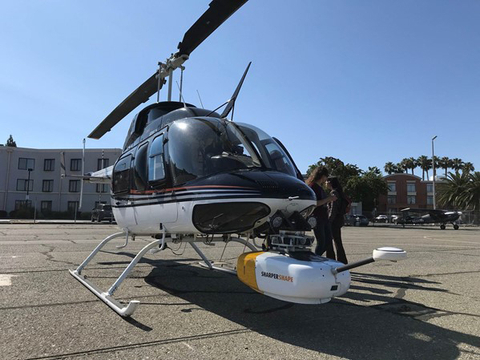OAKLAND, Calif.--(BUSINESS WIRE)--Through the end of October, Pacific Gas and Electric Company (PG&E) crews will survey electrical equipment, and the nearby vegetation, in 25 counties throughout Northern and Central California to spot and prevent potential wildfire risk. Helicopters equipped with Light Detection and Ranging (LiDAR) sensors and high-resolution imagery technology will evaluate PG&E powerlines and adjacent trees.
“Our most important responsibility is the safety of our customers and our hometowns we are privileged to serve and that includes doing everything possible to mitigate wildfire threats,” said Sumeet Singh, PG&E Executive Vice President and Chief Risk Officer and Interim Chief Safety Officer. “The high-tech tools at our disposal, such as this remote sensing technology, enhance mapping data and produce the sharpest scans. That level of detail and accuracy provides essential information on the condition and location of our equipment relative to nearby vegetation.”
A surveyor in the helicopter will collect the data on PG&E’s powerlines, poles, and the surrounding trees and brush located along distribution circuits within or adjacent to extreme (Tier 3) and elevated (Tier 2) wildfire risk areas (as defined by the California Public Utilities Commission (CPUC) High Fire-Threat District Map). This data is used to create a 3-D simulation of our facilities.
“This visual representation of our facilities gives us an accurate and unique picture to determine if there are potential encroachments near our equipment which could require safety improvements or maintenance,” said Peter Kenny, PG&E Senior Vice President for Vegetation Management and System Inspections. “Incorporating the data from these technologies will support the safe and reliable delivery of electricity to our hometowns.”
Additionally, the data is used to inform our machine learning artificial intelligence risk models to predict the potential risk of catastrophic wildfires from vegetation contacting our electric lines.
Two helicopters equipped with the LiDAR and high-resolution imagery technology will conduct surveys along distribution powerlines Monday through Friday, between the hours of 8 a.m. and 5 p.m. each weekday. Helicopters will be flying low, along the powerlines, at an altitude of about 500 feet, but will remain no lower than 200 feet.
Remote sensing is part of the company’s 2022 Wildfire Mitigation Plan, which outlines a bold, comprehensive set of actions to provide safe, reliable and affordable energy amid a changing climate and evolving wildfire threat.
Utilizing multiple methods to gather data—including patrols, physical testing of poles, ground, aerial, climbing, infrared and LiDAR—PG&E plans to complete inspections of transmission and distribution structures in extreme fire-threat areas, which includes more than 390,000 distribution poles and nearly 39,000 transmission structures.
For more information on how PG&E is working every day to reduce wildfire risk, visit www.pge.com/cwsp.
About PG&E
Pacific Gas and Electric Company, a subsidiary of PG&E Corporation (NYSE:PCG), is a combined natural gas and electric utility serving more than 16 million people across 70,000 square miles in Northern and Central California. For more information, visit pge.com and pge.com/news.



